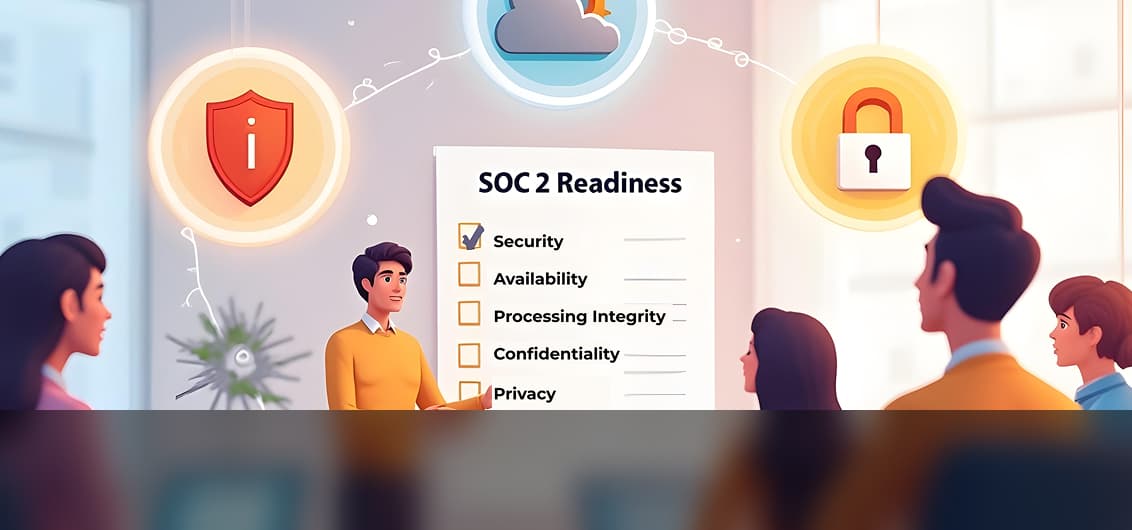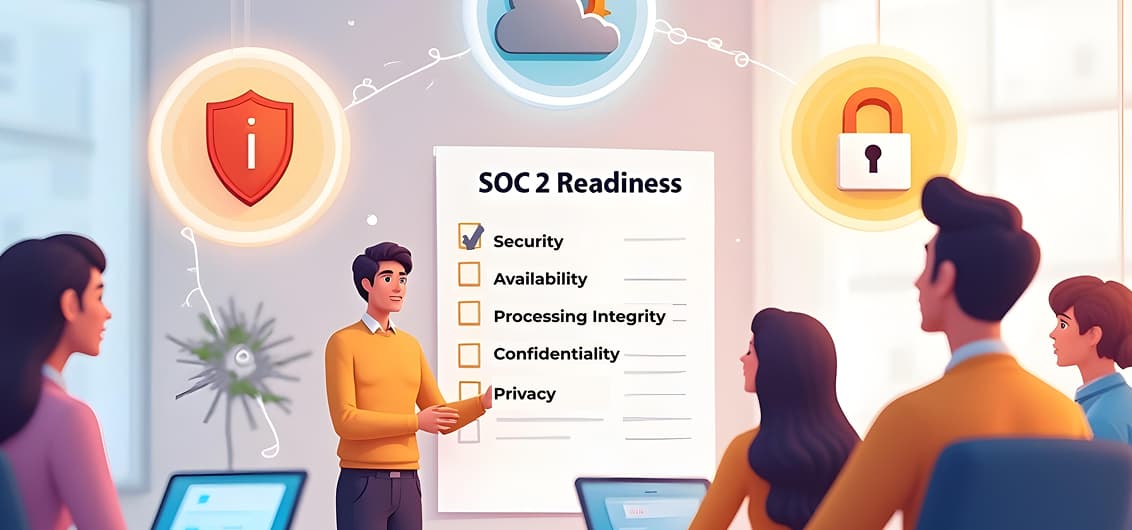Customers, partners, and regulators expect organizations to safeguard sensitive data and uphold the highest standards of security and privacy. For technology companies and service providers, achieving SOC 2 compliance is not just a badge of honor it’s often a prerequisite for doing business.
However, building a SOC 2-ready security program is about much more than passing an audit. It’s about embedding robust security practices into your company’s DNA, promoting a culture of compliance, and continuously improving to stay ahead of evolving threats.
Understanding SOC 2 and Its Importance
SOC 2 (System and Organization Controls 2) is an auditing standard developed by the American Institute of Certified Public Accountants (AICPA) for service organizations. Unlike prescriptive certifications (like ISO 27001), SOC 2 is principles-based and focuses on how organizations design and operate controls related to the five Trust Service Criteria:
Security (required for all SOC 2 reports)
Availability
Availability
Processing Integrity
Privacy
The flexibility of SOC 2 allows organizations to tailor controls to their unique business and risk environment, but it also means that preparing for SOC 2 requires a thoughtful, comprehensive approach.
Core Components of a SOC 2-Ready Security Program
To build a program that stands up to SOC 2 scrutiny and, more importantly, truly protects your organization and customers, you need to focus on several foundational components.
1. Access Controls
Access controls are the front line of defense against unauthorized access to sensitive data and systems. Effective access management ensures that only the right people have the right access at the right time.
Key Practices:
- Role-Based Access Control (RBAC): Assign permissions based on job roles, not individuals.
- Least Privilege: Users and systems only get the minimum access necessary to perform their functions.
- Multi-Factor Authentication (MFA): Require MFA for all sensitive systems, especially remote access and privileged accounts.
- Access Reviews: Conduct regular (at least quarterly) reviews of user access rights and promptly remove access for departing employees or changing roles.
- Automated Provisioning/Deprovisioning: Use tools to automate user onboarding and offboarding, reducing human error.
Access controls are central to the Security and Confidentiality criteria, helping prevent data breaches and insider threats.
2. Logging and Monitoring
You can’t protect what you can’t see. Logging and monitoring provide visibility into system activity, help detect suspicious behavior, and support investigations when incidents occur.
Key Practices:
- Centralized Logging: Aggregate logs from servers, applications, network devices, and cloud services in a secure, tamper-evident system.
- Real-Time Monitoring: Use Security Information and Event Management (SIEM) tools to monitor logs and generate alerts for anomalous activity.
- Log Retention: Retain logs for a period that meets business, legal, and regulatory requirements (often 12 months or more).
- Regular Review: Routinely review logs and alerts, and document responses to potential incidents.
Logging and monitoring are essential for Security, Availability, and Processing Integrity, enabling quick detection and response to threats.
3. Vendor Management
Your security is only as strong as your weakest vendor. Third-party providers (cloud platforms, SaaS tools, contractors) can introduce significant risks if not properly vetted and managed.
Key Practices:
- Due Diligence: Assess vendors before onboarding, including reviewing their SOC reports or security certifications.
- Contractual Controls: Ensure contracts include security, confidentiality, and incident notification requirements.
- Ongoing Assessment: Regularly review vendor performance and request updated security documentation.
- Vendor Inventory: Maintain a comprehensive, up-to-date list of all vendors with access to sensitive data or systems.
Vendor management supports the Confidentiality and Privacy criteria by ensuring third parties meet your security standards.
Mapping Trust Service Criteria to CISO Priorities
The Trust Service Criteria are not just audit checkboxes, they align closely with the strategic priorities of the Chief Information Security Officer (CISO) and the broader business. Here’s how:
CISOs should map their existing controls and risk management initiatives to the relevant TSCs, ensuring alignment with both compliance and business objectives.
A Maturity Model for SOC 2 Readiness
Assessing your organization’s readiness for SOC 2 is not a one-time checklist, but an ongoing journey. A maturity model helps you understand where you stand and what steps to take next.
How to Use the Model
Assess each core component (access controls, logging, vendor management, etc.) against this scale to identify strengths and areas for improvement.
Actionable Steps to Address Gaps
After conducting a maturity assessment or gap analysis, it’s time to close the gaps. Here are practical steps for some of the most common areas:
Incident Response Plan
- Develop a Formal Plan: Document roles, responsibilities, and procedures for detecting, responding to, and recovering from security incidents.
- Cross-Functional Team: Include IT, security, HR, legal, communications, and executive leadership.
- Run Tabletop Exercises: Simulate incidents to test the plan and identify weaknesses.
- Continuous Improvement: Update the plan after real incidents or exercises
Access Control Improvements
- Automate Onboarding/Offboarding: Integrate HR systems with identity management tools to ensure timely access changes.
- Regular Access Reviews: Schedule quarterly reviews of access rights, especially for privileged accounts.
- MFA Everywhere: Expand MFA beyond remote access to cover all critical systems.
Vendor Risk Management
- Centralize Vendor Inventory: Use a vendor management platform to track all third-party relationships.
- Standardize Due Diligence: Develop a questionnaire or checklist for evaluating new vendors.
- Annual Reviews: Reassess high-risk vendors at least annually.
Logging and Monitoring Enhancements
- Deploy a SIEM: Implement a Security Information and Event Management system to centralize and analyze logs.
- Define Alert Thresholds: Set up alerts for unusual activity (e.g., failed logins, privilege escalation).
- Review and Tune: Regularly review alerts and tune rules to reduce false positives.
Security Awareness Training
- Mandatory Training: Require all employees to complete security awareness training annually.
- Phishing Simulations: Conduct regular phishing tests to reinforce vigilance.
- Role-Based Modules: Tailor training for high-risk roles (e.g., developers, finance).
The Power of Cross-Departmental Collaboration
SOC 2 compliance is not just an IT or security project, it’s an organization-wide initiative. Here’s how different teams contribute:
- Implement secure coding practices, manage change control, and support technical controls.
- Participate in threat modeling and vulnerability remediation.
- Oversee background checks, onboarding/offboarding, and security training.
- Ensure policies are communicated and acknowledged.
- Advise on regulatory requirements, data privacy, and incident response obligations.
- Review contracts for security and confidentiality clauses.
- Provide sponsorship, allocate resources, and set the tone for a security-first culture.
- Resolve conflicts and champion cross-functional initiatives.
- Engage auditors, consultants, and managed service providers for independent assessments and expertise.
Form a cross-functional SOC 2 steering committee to oversee the program, coordinate efforts, and ensure accountability.
Continuous Improvement: Beyond the Audit
Achieving SOC 2 compliance is an important milestone, but it’s not the finish line. Threats evolve, business models change, and customer expectations rise. Make continuous improvement a core part of your security program:
- Regular Assessments: Conduct internal audits and readiness reviews at least annually.
- Metrics and KPIs: Track key performance indicators (e.g., incident response times, training completion rates) to measure progress.
- Stay Informed: Monitor changes in the SOC 2 framework, emerging threats, and best practices.
- Customer Feedback: Use customer questions and concerns as input for program improvements.
Conclusion
Building a SOC 2-ready security program is a journey that demands commitment, collaboration, and continuous learning. By focusing on core components like access controls, logging, and vendor management; mapping the Trust Service Criteria to business priorities; leveraging a maturity model for readiness; closing identified gaps with actionable steps; and fostering collaboration across all departments, your organization can achieve not only SOC 2 compliance but also a culture of security and trust.
SOC 2 is a framework for building resilient, customer-centric organizations in a digital world, but it can be quite a hassle if you're new to it. Start your SOC 2 journey today with Invimatic, and turn compliance into a competitive advantage.






Your email address will not be published. Required fields are marked *